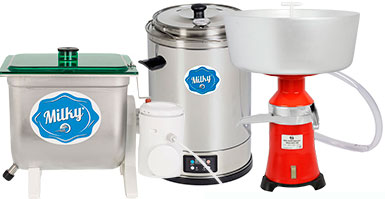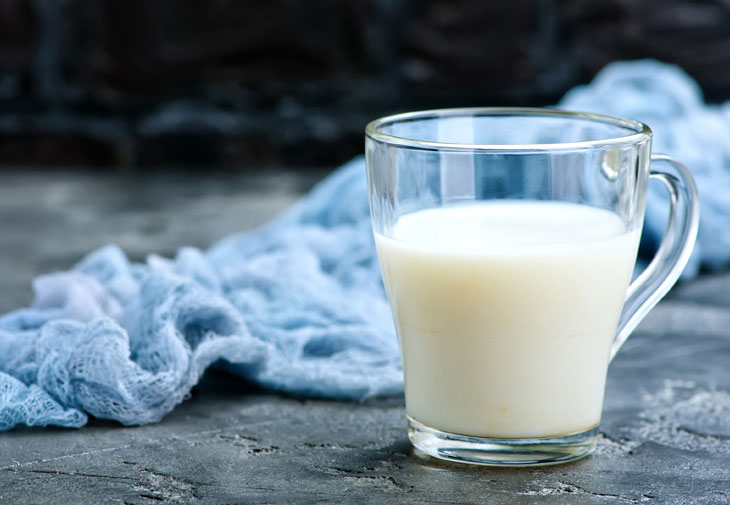Many baking recipes feature this mysterious ingredient: buttermilk. What is it? Is it some buttery milk? Do you get it by mixing milk and butter? Let’s explore this fascinating product and see if you should include it in your daily diet.
What is buttermilk?
When you churn butter, the fats get gathered into the spread we all love, leaving the liquid out. This liquid is traditional buttermilk. It’s quite a rare sight in the USA and Europe, but families in India, Pakistan and Nepal drink this product every day. Such buttermilk is lower in fat than milk because almost all the fat has gathered into butter. It’s lower in calories too and is a good source of vitamins and nutrients.
How do you churn butter? In a butter churn, of course! Discover our range of these machines suited for making butter at home and on small to medium dairy farms. Don’t hesitate to drop us a line if you need any help with choosing the equipment!
https://milkyday.com/products/butter-churns
In the US, you can find cultured buttermilk that’s created by adding bacteria that produce lactic acid to pasteurized milk. This is a fermented product – the bacteria develop their qualities within 12-24 hours. Thanks to the lactic acid, cultured buttermilk can be stored for longer than milk. Also, it tastes sour and is much thicker. This beverage has a lower pH level because of the lactic acid. While standard milk’s pH is 6.7-6.9, the pH level of cultured buttermilk is 4.4-4.8.
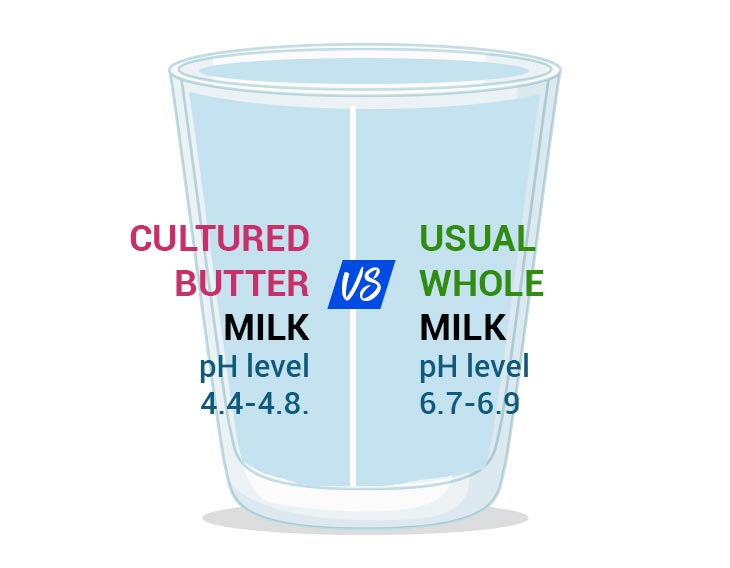
What is buttermilk used for?
Some people like drinking both cultured and traditional buttermilk as standalone beverages or by adding salt or some other spices to them. Also, buttermilk is often used for cooking. It works very well as a substitute for other dairy products in recipes. Buttermilk is popular as an ingredient for baking, as it adds tenderness to the texture and a richer taste. This beverage is very versatile and can be used for virtually any dish – as a salad dressing, in a smoothie or soup.

Since cultured buttermilk stays good for around two weeks if you store it in the fridge, it is very convenient for those who just use this product for cooking. Unlike with milk, you don’t have to worry that it spoils quickly.
What is the difference between milk and buttermilk?
As we’ve figured out the obvious difference between these products – they are two different beverages – let’s take a look at other dissimilarities.
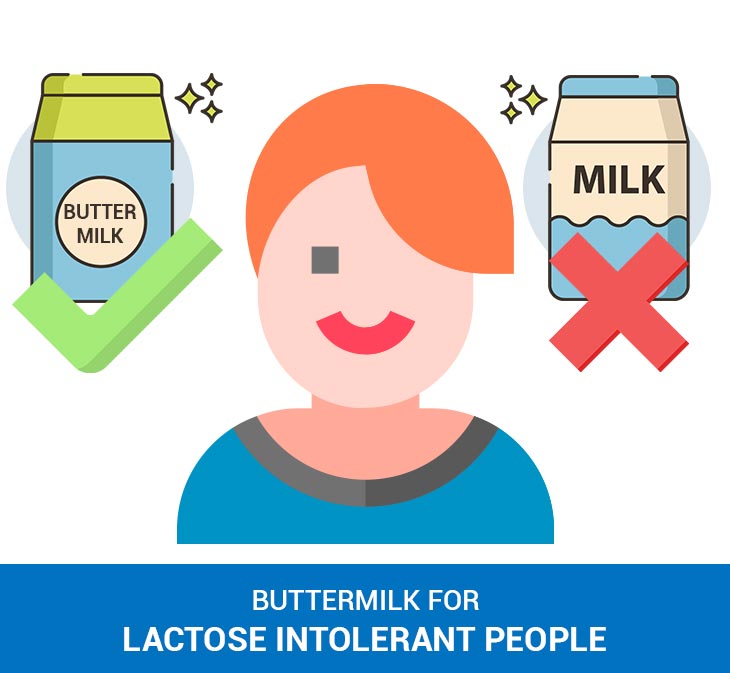
Cultured buttermilk might be a good choice for lactose-intolerant people because of the active cultures it contains. They can help you to digest lactose. However, the effect varies from person to person.
Also, fermented products are in general quite beneficial for our health. And as cultured buttermilk is a fermented beverage, it might reduce the risk of heart disease and improve digestion. Overall, it’s widely considered to be a healthier alternative to regular milk.
You can’t just make buttermilk without making some butter, too. And that’s a tasty bonus we’d say! Learn how to make butter from our article!
Buttermilk nutrition facts
245 ml (one cup) of cultured buttermilk contains only 98 calories along with 8 grams of protein, 12 grams of carbs and 3 grams of fat. Milk, on the other hand, has 157 calories and 8.9 grams of fat per 245 ml.
In addition, buttermilk is a good source of vitamin B12, calcium, potassium, phosphorus and riboflavin.
What are the benefits of drinking buttermilk?
As you’ve already noticed, buttermilk is a richer source of nutrients, and it’s lower in fat and calories. These and other features make this beverage rather beneficial.
Lactose-intolerant people might not experience issues with buttermilk
Lactic acid and active cultures make this product easier to consume for those who are lactose-intolerant. Of course, it depends on the individual sensitivity of the person. Some will have no side effects from drinking buttermilk, whereas others might experience all the negative consequences, such as bloating, nausea and abdominal pain. But overall, cultures in buttermilk might help to break down the lactose.
It’s better for digestion
Fermented products are known for improving digestion, especially if a person already has some gastric issues. Active cultures help the body process food. They have a somewhat cooling effect that can help to calm down the stomach after eating a spicy meal. Also, buttermilk might make you feel lighter and less tired after a very heavy meal.
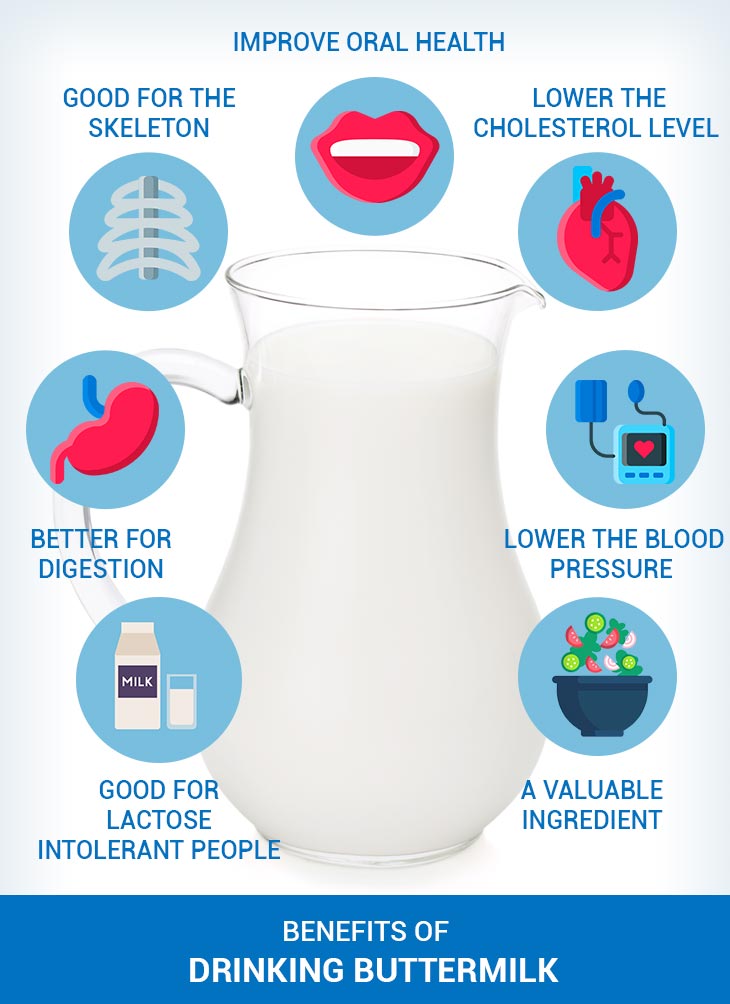
It’s good for the skeleton
As buttermilk is rich in calcium and phosphorus, it might help strengthen the bones and prevent osteoporosis and other bone diseases. Unlike standard milk, buttermilk is not that high in fats and calories, so you can consume this beverage to improve your bone structure without worrying about extra calories.
Active cultures can improve your oral health
Buttermilk has a cooling effect due to active cultures and lactic acid. So it can help with inflammation in your gums and body overall. And thanks to the calcium that is found in this beverage, you will lower your chances to develop periodontitis – the disease that causes inflammation of the gums and supporting structures of the teeth.
Helps to lower the cholesterol level
Studies have shown that buttermilk might help reduce cholesterol in the human body. Researchers suppose that this effect is caused by sphingolipid compounds that inhibit the absorption of cholesterol. Buttermilk’s milk fat globule membrane contains sphingolipids, so they’re a fair part of this product.
It might lower blood pressure
Research shows that cultured buttermilk might help lower blood pressure. Even though it’s not clear yet how exactly the beverage accomplishes this, we can assume that it happens thanks to the anti-inflammatory and cholesterol-lowering abilities of buttermilk. As the inflammation and cholesterol get reduced, it’s easier for the body to operate, and its blood pressure lowers.
A valuable ingredient
Buttermilk adds richness and tanginess to dishes while not significantly increasing their caloric value. Those who love baking cherish this product because it makes baked goods more tender, fluffy and tasty. Buttermilk is a good emulsifier and adds quite a lot of nutrients to our food.

How do you make buttermilk?
If you want to get traditional buttermilk, you can begin with churning your own butter. As the fat in the cream gathers into butter, you will get more and more of the leftover liquid. This liquid is what’s called traditional buttermilk. Using this approach, you will make two products at the same time: butter and buttermilk.
Wondering how a butter churn works? We told about it in our article! Read it to get a better understanding of how your tasty butter is made 🙂
If you want to make cultured buttermilk, there are several ways to do it. The simplest will be to use a buttermilk starter. You can search for one in grocery stores or on Amazon, for example. All you need to do is follow the instructions on the package of the starter. Usually, all you need to do is mix milk with the starter, cover the container with a towel and let it sit in a warm spot at 70°-77°F for 12-24 hours. Some people prefer the texture that develops after 12 hours. It’s up to you to experiment and see when you want to stop the fermentation process by putting the buttermilk in the fridge.
Another approach is to mix milk with lemon juice or vinegar. The ratio is 1 cup of milk or heavy cream – it depends on the amount of fat you want the buttermilk to contain – to 1 tablespoon of lemon juice or distilled white vinegar. Mix these two ingredients and let them sit at room temperature for around 5-10 minutes. The milk will thicken and form small curds.
Finally, you can culture store-bought buttermilk by mixing it with a starter or a special buttermilk starter. You can add a bit of milk as well to add sugar for bacteria to produce lactic acid. Once you mix buttermilk with a starter, you can leave it at room temperature for 18-24 hours. The longer you keep the mixture at room temperature, the thicker and tangier it will be.
Bottom line
Buttermilk is a great product both for cooking and consuming as a beverage. It has many health and taste benefits, and it’s quite easy to make at home. You can store it for up to two weeks in the fridge and even freeze it. However, health experts don’t recommend freezing fermented dairy products, as they can lose their benefits. The best thing about buttermilk is that if you make it at home, you can make it taste as you like.

